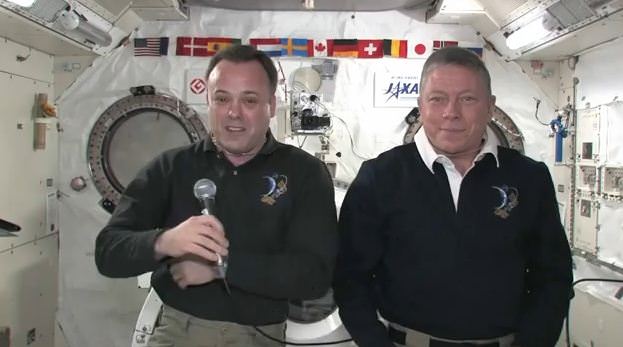[/caption]
The International Space Station has had a continual human presence for nearly 11 years, and so the astronauts now aboard the ISS are holding out hope that they won’t have to break that streak and turn out the lights and close all the hatches when they leave. Ron Garan and Mike Fossum said in a news conference with reporters on Tuesday that they have not yet been training for the possibility that they will have to leave the ISS unmanned due to a problem with the Soyuz rocket, the only ride astronauts and cosmonauts currently have to space.
“It’s too early for us to get too worried about that, frankly,” said Fossum, “and we haven’t started to do anything specific up here,except for documenting things we do on video. Fossum added that teams in mission control in Houston and Moscow are figuring out the procedures of what needs to be done if a problem with the Soyuz rockets can’t be figured out by November. “It will take us a few weeks to finish that up, but we have another nine or so weeks here, my crew of three. So we’ve got plenty of time for those kinds of things.”
Fossum said the ground crews are in the preliminary stages of deciding everything, “from what ventilation we’re going to leave running, what lights we’re going to leave on, what condition each particular experiment will be on, every tank, every valve, every hatch.”
A Russian rocket carrying a Progress resupply ship failed just after the third stage ignition two weeks ago and crashed into Siberia. While the Progress cargo ships launch on a Soyuz-U rocket and the Soyuz crew capsules — the Soyuz TMA — launches on a Soyuz-FG, the third stages of the two rockets are virtually identical.
Russian engineers said last week a malfunction in the third stage engine’s gas generator occurred; now they need to find out why and launch a couple of unmanned rockets before putting humans on board.
Right now a crew of six is on the station, with three of them scheduled to depart late next week – a week later than originally planned — to keep the station fully staffed as long as possible. A new crew of three was supposed arrive later this month, but that flight is on hold at least until early November, depending on the outcome of the investigation by the Russian engineers.
Since the space shuttles are no longer flying, the Soyuz is the only ride in town. While SpaceX is scheduled to send an unmanned Dragon capsule in a test run for bringing cargo to the station, the station would have to be abandoned if the Soyuz rocket isn’t cleared by November.
“It’s a complicated thing, when a rocket shuts down. It is a big deal,” said Fossum. “We’re not part of that investigation but we know what is going on. It’s not a fundamental design flaw, as this rocket has had hundreds of successful fights. But they are looking for what has changed.”
So, ground teams are now looking ahead for all the possible “what ifs” that might occur and Fossum and Garan said the big problem would be a short time span to do a crew handover – training in the new crew – or if they have to leave the station unmanned. They’ve started videotaping procedures and intricacies they’ve discovered about the station, just in case they aren’t there when a new crew arrives.
But it’s been a source of pride that there have been crews up here for over 4,000 days straight. “I think it is important,” said Fossum, “the station requires some care and feeding, and it is important for us to be here if we possibly can. If we have to shut it down for awhile, we will do our best to leave it in the best possible condition for the next crew to open the doors and turn the lights and and get back to work.”
The astronauts said if they do have to leave the station unmanned for a short period, it shouldn’t be a problem, but if the short gap turns into months, “the probability starts to stack up against you and leads to possibility that you would have a problem that could be significant without anyone up here to take action,” said Fossum.
Meanwhile, science operations are going full speed ahead. “We’re breaking records every week with crew-based research, over and above the autonomous research,” Garan said. “It’s important to note, that in the event we have to leave, there will still be science operations on board.”


Would Robonaut2 be of any help?
I would guess that while Robonaut2 is operated from the ground, astronauts are heavily involved in preparing it for operations.
I could be wrong, as I don’t have any specific information about it, but it seems like the fact that it was designed to be so versatile means that there would have to be some on-site prep work to get it ready for whatever specific task it was doing, whether that would mean removing it from storage/powering it up/calibrating it, or even just getting the tools/replacement parts it would need for the job.
do to a crew handover? really? how’s ’bout “due to “
The sentence is ” to do a crew handover.”
oh, i’m sorry, my mistake